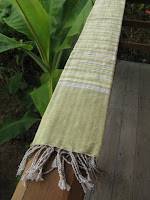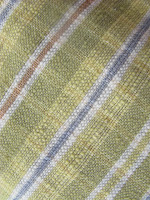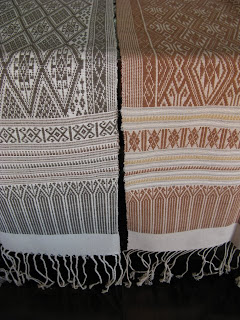Tuesday, April 27, 2010
Visit our new blog!
Monday, January 26, 2009
#8: Of peacocks & indigo
 We came here in search of handwoven cotton khram (indigo) textiles, an art practiced for generations in this area. These luscious blues have been very popular at previous TAMMACHAT events; probably because so many of our customers have the same hair colour that I do -- although it would be a challenge to name any colouring that doesn't look great with one of the umpteen shades of blue that can result from this natural dye, depending on the fibre, the season, the method of processing and the number of dye baths. We've been told that even the time of day is a factor -- BTW, early morning is the preferred time to dye the yarns.
We came here in search of handwoven cotton khram (indigo) textiles, an art practiced for generations in this area. These luscious blues have been very popular at previous TAMMACHAT events; probably because so many of our customers have the same hair colour that I do -- although it would be a challenge to name any colouring that doesn't look great with one of the umpteen shades of blue that can result from this natural dye, depending on the fibre, the season, the method of processing and the number of dye baths. We've been told that even the time of day is a factor -- BTW, early morning is the preferred time to dye the yarns.I'm happy to report that our search has been very sucessful; we have not only found indigo products but we've found them made by women's groups in 2 different provinces and numerous districts, encompassing hundreds of kilometres, women and items!
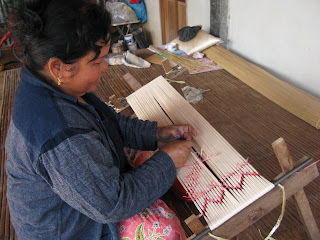

Already on their way to Canada are some exceptional mudmee patterned indigo scarves. Mudmee, as some of you know, is a process of tyeing and dyeing the yarns before they are woven. These variegated yarns then line up on the loom, resulting in elaborate geometric, and sometimes figurative, patterns.


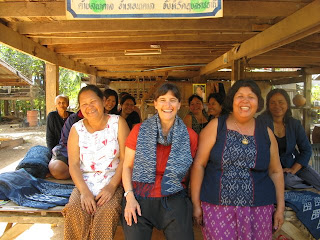 We visited one weaving group on the banks of the Mekong, where we were able to see and photograph each step of this process. While we were there we hosted a luncheon get-together with the group, where much laughter as well as great food was shared. We especially enjoyed a hilarious lesson on the correct pronunciation of Mae Nam Khong (Mekong River in Thai) -- next time you see Ellen, ask for a demonstration.
We visited one weaving group on the banks of the Mekong, where we were able to see and photograph each step of this process. While we were there we hosted a luncheon get-together with the group, where much laughter as well as great food was shared. We especially enjoyed a hilarious lesson on the correct pronunciation of Mae Nam Khong (Mekong River in Thai) -- next time you see Ellen, ask for a demonstration.We rushed off from those visits in Ubon province to come north to Sakhon Nakhon, when we heard a provincial fair was in full swing where many weaving groups that specialize in indigo would be selling. Although we were invited to visit their villages, we settled on purchasing goods at the fair this year and have promised to return next year (prior to the fair's launch) to take them up on their hospitality and see first hand the work in progress.
We're sure that the many shades of indigo and the many styles of weaving that we're sending home today will make everyone an indigo fan.
Ellen has taken pictures of someone (?) wearing a selection of these wonderful cotton scarves with close-ups so you can see the woven patterns.




On a final note, a more personal anecdote: I was disappointed that, unlike in most other provincial capital towns, absolutely no one rents motorbikes here. I had hoped that we would have at least one day to toodle around and see the sights -- maybe have a serendipitous encounter with some weavers or ??? -- but without wheels it didn't seem possible. Anyway, having a little more time on our hands than anticipated, we returned to the fair where we saw a vendor who'd not been in her stall on our earlier visit. Not only did we find 2 more styles of scarves that we're sure will be a hit, but we also had a wonderful conversation and received another invitation to visit her home. Last but certainly not least, when she heard of my unrealized intention to rent a motorcycle, she offered me hers. After my 2 requisite polite declines, she was still insisting so I took her up on her offer, without so much as a baht (the Thai currency) or a passport as collateral. So...yesterday we had a fine time driving through the Phou Pan National Forest district and visiting the Phou Pan Palace. (Palaces are customary Thai tourist sites when there are no Royals in residence.)
 And finally, here is one of the many Thai peacocks we saw at the Royal Palace, strutting his stuff!
And finally, here is one of the many Thai peacocks we saw at the Royal Palace, strutting his stuff!Until next time,
Pii Plaa (aka Alleson)
Thursday, January 22, 2009
#7: Organic cotton along the Mekong
Monday: 19 January 2009: Khong Chiam, Ubon, Thailand
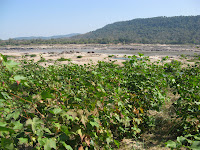 This week we will continue our visits with members of some of the groups that work with the Pattanarak Foundation. Today we went to some women's homes. Last week, our study tour began with a visit to one couple's organic cotton field on the western bank of the Mekong River, where cotton, corn, vegetables and herbs are planted when the waters ebb as "cool" season begins.
This week we will continue our visits with members of some of the groups that work with the Pattanarak Foundation. Today we went to some women's homes. Last week, our study tour began with a visit to one couple's organic cotton field on the western bank of the Mekong River, where cotton, corn, vegetables and herbs are planted when the waters ebb as "cool" season begins.We spent most of the rest of last week at a community learning centre, where a lively group of 7 women introduced us to their traditional production of cotton. They have perfected each step from the removal of the cotton seeds, to the fluffing, rolling and handspinning of the cotton yarns, which are then dyed with natural materials, dried and then re-wound several times to ready them for the loom. [Ellen will post a photo essay of this process when she gets access to a computer with the necessary software.]
The learning centre, built 2 years ago, is used primarily as a training centre for group members, local students and visitors from other weaving groups. It also houses a shop, where products are available for sale. Group members, like many women, work in their own homes surrounded by children and extended families, squeezing the work between their other responsibilities as mothers, wives, farmers, caregivers, etc.
Today we drive to a village of about 250 people who are primarily sustained by farming and fishing. The first home we go to doubles as a corner store. The woman here frequently rises fom her loom to sell a packet of washing powder or a bit of something else. In between customers, she returns to her weaving or to taking care of her children who, although small, appear old enough to be attending school but aren't.
 The work on her loom is of particular interest to us because, unusually, both the warp and the weft are handspun. This means that the fabric she's producing is 100% organic, as well as thicker than the cloth produced from factory yarns. She is weaving with a 2-ply yarn so, when she is able to sit down, the work progresses quickly. She explains that she has not spun the yarns herself, despite the presence of 3 rustic spinning wheels nearby. Instead, she has bought the yarns from the village spinning group. "Baw mee waylaa wang," she shrugs, as she motions with her chin -- in the way people here do -- to the shop, the children and the house. "No time."
The work on her loom is of particular interest to us because, unusually, both the warp and the weft are handspun. This means that the fabric she's producing is 100% organic, as well as thicker than the cloth produced from factory yarns. She is weaving with a 2-ply yarn so, when she is able to sit down, the work progresses quickly. She explains that she has not spun the yarns herself, despite the presence of 3 rustic spinning wheels nearby. Instead, she has bought the yarns from the village spinning group. "Baw mee waylaa wang," she shrugs, as she motions with her chin -- in the way people here do -- to the shop, the children and the house. "No time."Aew, the Pattanarak field worker who is acting as our guide, asks the woman to bring out some already completed weaving, which is nothing like the white hand towels presently on the loom. We look through the pieces, which have an interesting mix of thick and thin yarns, designs resulting from both continuous and discontinuous supplementary warps and a choice of two colour palettes.
We choose 5 pieces that we will market as table runners. What a concept; what a contrast. There isn't a dining table in sight; only a cement sitting platform, covered with ceramic tiles, and little else.
The 3 of us continue our walkabout. Our next stop is at a tiny building of cement blocks, which have neither a skim coat of cement nor paint applied. What sticks in my mind, 6 hours later, are the battered and rusted pieces of corrugated roofing material that are nailed over the windows.
Outside, there are 2 young women and 2 very young children. One of the young women squats on the hard-packed dirt in from of the front door, while she winds soft green yarn onto bobbins with a spinning wheel of the type also used to spin cotton yarn. There is also a middle-aged woman, one of the women's mothers, we're told, standing by a well-used rice winnowing basket that contains several skeins of cotton yarns in 2 shades of green.
All of the yarns used in these villages are coloured with natural dyes made from locally gathered materials. The dyers pay particular attention to harvesting them sustainably to ensure a continued supply.
I take a closer look at the loom alongside the house. On it is a narrow warp of fine cotton yarn that has been spun in a factory. The thicker, handspun yarns are better suited to other types of weaving. I continue my inspection and count 20 sets of string heddles suspended from bamboo poles over the warp. "Photograph the heddles," I motion to Ellen, who always has her camera in hand. "They're fabulous."
We had been told in advance that this is a village where khit (supplementary weft weaving) is done. In particular, this woman weaves the elephants that are used as a decorative motif on many of the bags we've seen at Pattanarak's shop in Khong Chiam. The complex string heddles shape the elephant design that she weaves.
While the young woman winds the bobbins, we go next door to pay our respects to Yai, the 83-year-old grandmother who, as a young woman, came across the river from Laos to marry, raise a family and eventually teach daughters and granddaughters how to artfully manipulate the string heddles. Bundles of these threads tied to bamboo splints hang from various houseposts in the compound. They are the inheritance of their Lao foremothers: the heddles that the grandaughters have the stamina and eyesight to use, but do not yet have the skill to tie for themselves.
We sit with Yai while Aew steps outside to answer her mobile phone. It's hard not to look away from the old woman's gaze as she speaks a steady stream of village-accented Lao. Her mouth is a red slash of crumbled teeth and blackened gums; her skin appears to be a deep hepatitic yellow. Tiny and wrinkled, she appears shrivelled into a pile of skin and bones on the cement floor. I pick up the occasional phrase, which I optimistically weave into a meaningful narrative. I tell Ellen that she might be saying that now that she is 83 years old she should be dead already, like her contemporaries, but she does not die. The betel chewing has ruined her teeth, but not her health apparently. [Betel - the leaves and nuts of a local tree - is chewed throughout Southeast Asia for its social and psychotropic qualities. Particularly common among older women, we see betel being chewed in every village in Thailand.] Likewise, the tumeric-infused oil has kept her skin pliable, if yellow. When Aew returns and we are able to take our leave, we back out of Yay's presence with silent but hopefully graceful wais. [This is the gracious method of greeting and taking leave of people in Thailand and Laos, with hands brought together respectfully in front of you.]
 We return to the loom next door to find the 2 young women working together; one is throwing the shuttle and the other is manipulating the bamboo sticks that control the string heddles, speeding up the work. In our 10-minute absence they have woven several rows of elephants, which they are now examining with Aew. The woman seated at the loom points out that the elephant on the far left of the piece is not quite like the others. It takes a practiced eye to spot the discrepency but clearly the weaver is not satisfied.
We return to the loom next door to find the 2 young women working together; one is throwing the shuttle and the other is manipulating the bamboo sticks that control the string heddles, speeding up the work. In our 10-minute absence they have woven several rows of elephants, which they are now examining with Aew. The woman seated at the loom points out that the elephant on the far left of the piece is not quite like the others. It takes a practiced eye to spot the discrepency but clearly the weaver is not satisfied."Tomorrow," Aew translates, "she will have all of them pretty and she will begin to weave."
I understand that this means that some part of today will be spent correcting the strings responsible for the misshapen elephant, as well as winding the rest of the yarn onto bobbins, so that tomorrow the weaving can begin in earnest. I am reminded of a comment made several years ago by another weaver: "By the time you're ready to sit down at the loom to weave," she had said, "most of the work is already done."
 The next house we visit is the home of the village weaving group's "fabric banker." She is weaving an open weave, fine cotton scarf alternating white and salmon on a white warp. With Aew's help, we clarify that another group member acts as the microcredit "banker" for the revolving savings and credit program that the weaving and spinning groups in the village have established with Pattanarak's help. We had discussed the group, its numbers, practices, products and history during our drive to the village this morning, so much of what we were seeing is an illustration of those discussions. Nonetheless, the reality is both more complex and more poignant.
The next house we visit is the home of the village weaving group's "fabric banker." She is weaving an open weave, fine cotton scarf alternating white and salmon on a white warp. With Aew's help, we clarify that another group member acts as the microcredit "banker" for the revolving savings and credit program that the weaving and spinning groups in the village have established with Pattanarak's help. We had discussed the group, its numbers, practices, products and history during our drive to the village this morning, so much of what we were seeing is an illustration of those discussions. Nonetheless, the reality is both more complex and more poignant.The 4 of us go inside her home, while a half-dozen neighbours, extended family and/or group members gather on the outdoor sitting platform, constructed in the more traditional manner: hardwood boards supported by posts that had been dug into the hard-packed earth. While we look at the weaving stored higgly-piggly in a glass cabinet inside, someone comes in and hands our hostess a large toddler who is clearly ready for a pre-nap lunch.
 While she nurses, we examine the various pieces. Aew occasionally translates our comments and preferences; our recommendations are noted, as the purpose of this visit is to help the weavers better understand market preferences. Eventually, we choose several dozen pieces. As is my habit, I fold everything, whether or not selected, to a standard size to fit the cabinet. When we are finished and a bill reckoned, the woman thanks me, through Aew, for putting everything back so neatly. Ellen explains that it's a habit that I'd acquired as a child from my father who had sold shirts for a living. This explanation is entirely appropriate, I thought, for people who, until recently, learned almost everything from their parents, beginning at a young age when play and work were not yet differentiated.
While she nurses, we examine the various pieces. Aew occasionally translates our comments and preferences; our recommendations are noted, as the purpose of this visit is to help the weavers better understand market preferences. Eventually, we choose several dozen pieces. As is my habit, I fold everything, whether or not selected, to a standard size to fit the cabinet. When we are finished and a bill reckoned, the woman thanks me, through Aew, for putting everything back so neatly. Ellen explains that it's a habit that I'd acquired as a child from my father who had sold shirts for a living. This explanation is entirely appropriate, I thought, for people who, until recently, learned almost everything from their parents, beginning at a young age when play and work were not yet differentiated."Never mind," I said in the local dialect. "You don't have any free time," I added as I motioned to the weaving bank, the child in her lap, the loom outside the door. Her broad smile seemed to show that she had understood and appreciated my comment as well as my compulsive tidying.
We leave our purchases behind, along with a promise to return, and walk over to the next member's house. Aew explains that most of the members are out in the fields farming today, so our visit will be a little shorter. Perhaps they had forgotten our scheduled visit or maybe they considered bringing in their cassava harvest more important. Regardless, we were not offended. There were enough members at home with very young children, as well as those too old or infirm to do the heavy work that cassava requires.
Our next stop apparently falls into the latter category. Under the house, on the ubiquitous sitting platform, are 2 elderly women, lying down but not quite asleep. The various small tools and the mouths of the 2 women attest to the betel chewing session in progress.
 We are introduced to the elder of the 2 women who is extremely hard of hearing and, from the look of her milky eyes, sight impaired as well. Aew explains that these days she mostly spins cotton and leaves the weaving to her daughter, but that she is a master weaver of khit. As if the woman understood Aew's explanation, she rises and sits at the loom where a tablecloth is in progress. Despite her obviously failing eyesight, the number of bobbins involved and the width of the piece, she proceeds to weave several rows while Ellen, having asked permission to photograph, puts her camera on video record. "Got it," she grins.
We are introduced to the elder of the 2 women who is extremely hard of hearing and, from the look of her milky eyes, sight impaired as well. Aew explains that these days she mostly spins cotton and leaves the weaving to her daughter, but that she is a master weaver of khit. As if the woman understood Aew's explanation, she rises and sits at the loom where a tablecloth is in progress. Despite her obviously failing eyesight, the number of bobbins involved and the width of the piece, she proceeds to weave several rows while Ellen, having asked permission to photograph, puts her camera on video record. "Got it," she grins.After her demonstration, she resumes her place on the platform with her companion. With Aew's help, we piece together their history, despite the difficulty posed by women who either can't remember, can't count or don't consider important, the numbers involved in their personal histories. They are sisters, maybe literally, maybe figuratively. Regardless, they are 6 years apart in age and came over the river together from Laos to Thailand to marry Thai men in this village. It's likely that they were 14 and 20 years of age at the time and that was about 40 or 50 years ago. Many of the women in the village are originally from Laos. This program builds on skills acquired long ago, as most of the women learned to weave from their mothers when they were about 10 years old.
Since the group began in the village 15 years ago, many of these women have received additional training in spinning, natural dyeing, weaving and/or product design from other rural weavers participating in similar groups in several of the neighbouring provinces. Each of the groups has access to somewhat different plants and qualities of water, so dyeing is often an experiment, regardless of the experience of the dyer. This woman had apparently helped train not only her daughter but others in khit weaving, before she retired to her spinning wheel, a process so well known by her hands that vision was unimportant.
 Again, we take our leave and return to the home of the "fabric bank" member, where we pick up our purchases. While we'd been gone, her husband had twisted the fringes on 9 shawls we'd chosen, which had been unfinished only 45 minutes ago. He was not the only man we saw engaged in fibre work, although all of the weaving groups' members are women; Ellen and I had both remarked earlier at the complex and fine fishing gear being netted by another man in the village.
Again, we take our leave and return to the home of the "fabric bank" member, where we pick up our purchases. While we'd been gone, her husband had twisted the fringes on 9 shawls we'd chosen, which had been unfinished only 45 minutes ago. He was not the only man we saw engaged in fibre work, although all of the weaving groups' members are women; Ellen and I had both remarked earlier at the complex and fine fishing gear being netted by another man in the village.After a full morning, despite the exodus of most of the village to their cassava fields, we retired to the general store/restaurant where we encountered staff (perhaps the entire staff) of the adjacent school, easily identified by their crisp, military-like uniforms. The principal made it his responsibility to formally welcome us to the village as well as interview us in his better than rudimentary English. Before we left, he presented us with 5 kilos of yams, recently harvested.
Our daily life is always curious here, especially because of the juxtaposition of unlikely events. As if to illustrate my point, the eldery sisters walk by with towels on their heads, to protect from the mid-day sun, digging sticks in hand. They are off to their cotton fields where they, along with villagers in 5 counties on the banks of the Mekong, produce more than 2,000 kilos of organic cotton bolls per season.
This is what community development and poverty reduction looks like up close, along the banks of the Mekong, across the river from Laos. Buying from these rural women's groups meets our definition of fair trade and we are grateful for Pattanarak's help in introducing us to these women and working with us on special orders we design together for our Canadian market.
 We hope you'll take a close look at the tablecloths, placemats, indigo jackets, scarves, bags and even cotton elephants we bring back and see the diligence, perserverance and life skills woven into every one.
We hope you'll take a close look at the tablecloths, placemats, indigo jackets, scarves, bags and even cotton elephants we bring back and see the diligence, perserverance and life skills woven into every one.Pii Plaa (aka Alleson)
#6: Pattanarak Foundation: weaving fair trade & development
Each piece of cloth (or finished textile product) involves many participants and processes, which add value at each step, to the initial raw commodity – fibre. Adding value and allowing people to earn income in their own communities are major goals of community development. At the same time, those additional steps make it difficult to employ the cooperative model common to agricultural commodities, such as coffee or sugar.
These issues were illustrated this week and last when we spent 8 days with villagers working with the Pattanarak Foundation, a non-governmental organization that works with disadvantaged populations in the rural border areas of Thailand.
Pattanarak has established numerous cotton production groups along the Thai-Lao border to help women set up a sustainable source of income in their “Alternative Livelihoods" program. With social networks and skills developed through these groups, as well as the income they make through the program, many women have gone on to participate in other community development programs, such as group savings and loans schemes.
To learn about Pattanarak first hand, and to see whether we would consider products purchased from them “fairly traded,” we signed up for a study tour with Pattanarak. We were based in Khong Chiam, home to the Nam Song Sii (i.e., Two-Colour Water), where the mighty Mekong meets the Moon River. We learned more about how villagers grow cotton without chemicals along the banks of the Mekong and how they transform them into extraordinary cloth – entirely by hand. And we were able to spend time with a number of the women involved with the program.
As we said throughout our time with Pattanarak, we were having “fun with language” too, each day building our Thai language skills with Aew, our capable and skilled development guide, who used our time together to grow her own English vocabulary and comfort speaking. Our 2 dictionaries were well-thumbed and our textile-related Thai (and Aew's English) vocabulary grew by leaps and bounds.
Ellen will post a photo essay to illustrate the entire production process – from growing the cotton organically along the banks of the Mekong to the finished fibre product, whether a bag, shirt, tablecloth or stuffed elephant!
And I will post another entry about TAMMACHAT, Pattanarak and fair trade that I hope will shed more light on what we're learning about what fair trade really means at a village level.
Happy reading!
Pii Plaa (aka Alleson)
Sunday, January 11, 2009
#5: Happy In: visiting Panmai Group
The weather was fine and the roads were paved so it was all good, if a little crowded. At our destination, we checked into "The Happy In" (sic): a 'no-tell mo-tel' where clients' vehicles are discreetly parked behind hot pink curtains, rooms are equipped with large horizontal mirrors and condoms are free. We're told that it's also the only accommodation in town that has hot water showers and air conditioners. We appreciate the hot water and laugh about the rest, as do the locals when they ask us where we're staying.
The best part of the story, however, is the fact that Panmai seems to be doing better every time we visit them. Or perhaps the best part is the incredible colours that the group's members are able to achieve when they dye their village-raised, organic silk with local barks and other plant stuffs.
Regardless, the 2 days we spent with their 3 staff women were very productive. We chose more than 100 beautiful silk scarves in nature's rich shades of magenta and burnt orange, cedar and salmon, indigo and ebony. We also created and assembled 3 palettes of our popular silk squares (275 pieces!) including 2 new mudmee patterns -- one in a frosted cherry and one in a spray of spring leaves. (You'll have to wait to see these new palettes in person, but we'll have them on our website in April.)
We also discussed world economic trends with the office staff; all of us strategizing about sustaining our businesses in this time of economic downturns. They told us how important their export customers are for them and explained their new pricing structure that discounts domestic sales to remain competitive. We assured them that we were OK with the price differential that results in approximately 15% higher prices for their foreign customers, pricing more in line with what the weavers think they really should be receiving for their work.
We, in turn, explained that we could choose slightly narrower and/or shorter scarves, sizes which are actually well suited to our customers' tastes, and thereby maintain a lower price per item despite the double whammy of the Canadian's dollar's decline and the economic downturn.
By the end of the 2nd day, after much sticky rice and really spicy papaya salad, and after much translating, laughing and productive labour, we saw our box of treasures go off to the post office, said our goodbyes andf got onto the next bus, headed east-southeast to Ubon.
We left with the good feeling that TAMMACHAT, along with Panmai, will likely find a way through these economic troubles: not by squeezing our suppliers but by finding fair ways to keep prices in line with our customers' means.
Pop gan mai (Until next time),
Pii Plaa (aka Alleson)
#4: Pa Ao Weaving Group: silk specialists
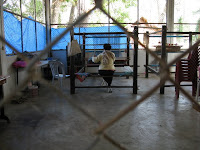 This group is one of many that has received OTOP recognition. OTOP -- One Tamboon, One Product -- is a program started many years ago by a previous government. It gives star ratings to products that range from foods to simple handicrafts to superb textiles, designating products considered outstanding in each district. The Pa Ao Weaving Group, which also refers to itself as Glum Satrii (Homemakers' Group), has received 4 and 5 star OTOP ratings in past years for its superlative weaving.
This group is one of many that has received OTOP recognition. OTOP -- One Tamboon, One Product -- is a program started many years ago by a previous government. It gives star ratings to products that range from foods to simple handicrafts to superb textiles, designating products considered outstanding in each district. The Pa Ao Weaving Group, which also refers to itself as Glum Satrii (Homemakers' Group), has received 4 and 5 star OTOP ratings in past years for its superlative weaving.On that first visit, we bought several naturally dyed silk scarves from the group's village shop. Unlike any designs we'd seen before, these scarves showcased mudmee designs (the tie-dyeing of the thread prior to weaving) with a seldom-seen contemporary flare.

We had hoped to meet this group again at last year's OTOP fair in Bangkok. Remarkably, we did find the group amongst the hundreds of stalls at last year's fair but they didn't have the scarves we were searching for and we were unable to describe them well enough to make an order.
Which brings this post to yesterday, when we set out on another rented motorbike in search of these unusual scarves. We arrived in the early afternoon to find 3 very helpful women at the Ban Pa Ao weaving shop but not the elusive scarves.
Rather than trying to persuade us to consider the conventionally dyed scarves that some of their members continue to produce, the staff took the opportunity to bring out some extraordinary, handwoven, naturally dyed silk fabrics that are available by the metre. We couldn't resist buying 5 particularly beautiful pieces (3 of which are shown below). These will be available upon our return home to Canada in April.
 This piece has an amazing sheen with small vertical stripes. It's dyed with indigo and coconut husks soaked until the colour leaches into the water.
This piece has an amazing sheen with small vertical stripes. It's dyed with indigo and coconut husks soaked until the colour leaches into the water.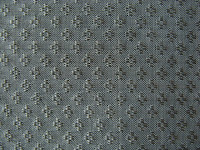 This piece is woven in a delicate flower pattern called dok pikhuun. It has a soft gray colour that is created with a dried fruit that is then boiled, pounded and soaked until the dye bath is ready.
This piece is woven in a delicate flower pattern called dok pikhuun. It has a soft gray colour that is created with a dried fruit that is then boiled, pounded and soaked until the dye bath is ready. This piece has a delicate shimmer obtained with jackfruit wood, another wood called prahot and coconut husk. The colours are made stronger by the addition of sai bua in which the silk yarns are soaked for a few days. It uses a mudmee design in the umber and pale green stripes, twisted threads and a white weft (cross-wise threads), which gives the shimmer.
This piece has a delicate shimmer obtained with jackfruit wood, another wood called prahot and coconut husk. The colours are made stronger by the addition of sai bua in which the silk yarns are soaked for a few days. It uses a mudmee design in the umber and pale green stripes, twisted threads and a white weft (cross-wise threads), which gives the shimmer.Because we follow a fair trade model, we wanted to learn not just about these production details but also about the group which has mastered them: the group with whom we are working to establish a relationship. Here's some of what we've learned:
- The group was started 22 years ago.
- Ten years ago, it had 75 members and has since grown to 108, all local Pa Ao village residents.
- Group members use chemical dyes and natural dyes, particularly local materials like kram (indigo), lac (which produces lovely pinks and reds) and magrua (ebony black). They have since learned to dye with other natural materials, such as coconut and jackfruit wood.
- All dye materials are gathered locally.


At the group's shop and weaving centre, we were shown samples of dye materials and silk yarns that had been dyed with them. Here you see Alleson and Nan, a group member, looking at samples of natural dye baths prepared by local students.
Our visit was not quite what we had expected but this is always part of the fun. Thanks to Alleson's ability to speak Thai, we learned more about the group and how they make such delicate colours using natural dyes from their local environment. Thanks also to her ability to read Thai (albeit slowly), we also learned the Thai names of several dye materials new to us.
Each new word helps us communicate better with the Thai weavers from whom we buy textiles. (My Thai is still rudimentary but my ability to understand and speak grows slowly, but daily, as we travel.) Being able to communicate, even a little, with the weavers enriches our understanding of their traditions and practices. It also allows us to bring you more stories about the creation of these incredible fibre arts.
Nok Noi (aka Ellen)
Thursday, January 8, 2009
#3: Prae Pan Group in Thailand
In our last post we affirmed our desire to support the highly skilled women who continue their tradition of creating silk and cotton yarn, natural dyeing and hand weaving despite the challenges posed by globalized modernization and the current economic downturn.
A case in point was our recent visit to the Prae Pan Group in Khon Kaen, Thailand, which we first visited 4 years ago. They still produce beautiful weaving, still have an impressive inventory of finished pieces and still have an active storefront in Khon Kaen, which is Thailand's 4th largest city. However, despite 2 decades of success, this group is finding it increasingly difficult to stay afloat.
Khon Kaen, by the way, is one of our favorite Thai cities. There's a large park with a small lake in town that Ellen is happy to walk around every morning and a large number of tasty noodle shops and khaow mun gai stalls where we can have cheap and tasty meals. It appears that very few tourists visit Khon Kaen, which may help explain why most people there are extremely welcoming to us. However, this also means that there are very few tourists, foreign or Thai, visiting the Prae Pan shop. It's not surprising that sales are down.
The bulk of the people in Khon Kaen province are rice farmers who live outside the provincial capital. More and more often, their young people are moving to urban areas where they can experience urban life and modern trends. At the same time, many factories are opening in the rural provinces where there's a surplus of labourers accustomed to hard work and low wages. All of these reasons add up to a growing pessimism whether rural women's groups like Prae Pan are actually sustainable and whether younger women will have learned the necessary skills to continue the tradition before their mothers and grandmothers are no longer available to teach them.
Consequently, we've decided this year to focus our selection of Prae Pan's work on a traditional style of khit weaving (using supplementary wefts), which the group's board members tell us may not be available in the coming years. We've selected ancestral patterns with design qualities that transcend their original meanings so to be appreciated by those outside the culture which produced them. We've also chosen sizes and colours that are well-suited to decorate tables, chests and dressers. We hope you'll agree.
Pii Plaa (aka Alleson)





